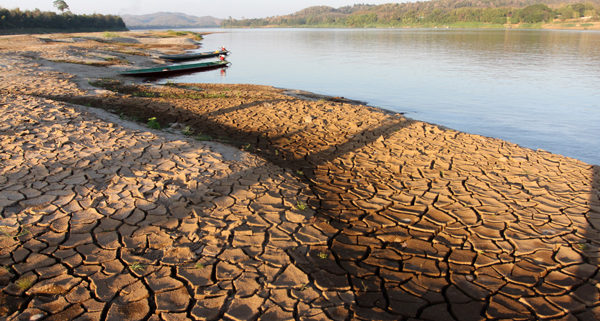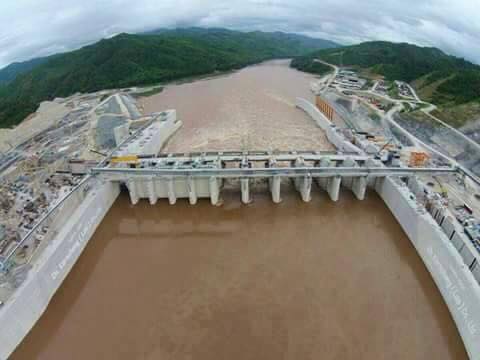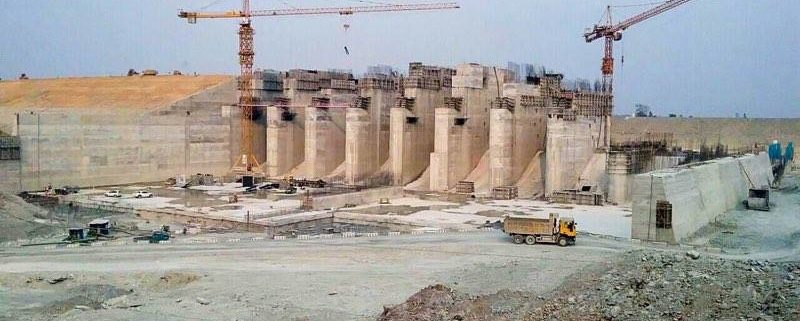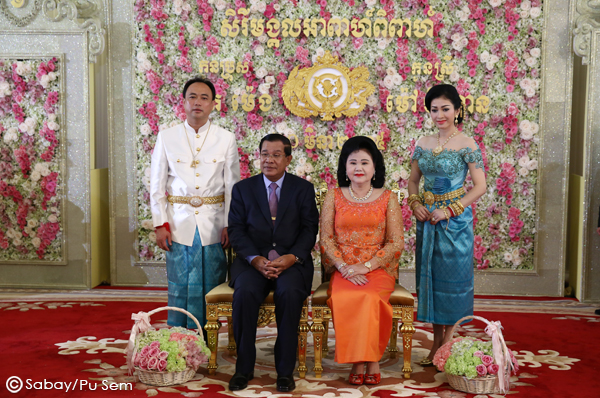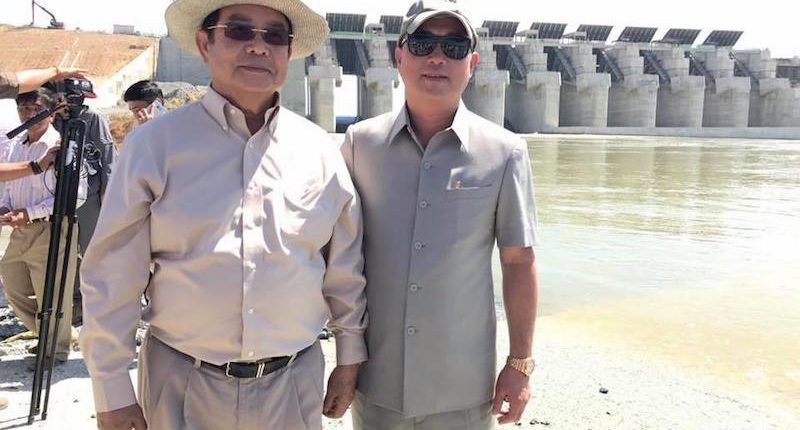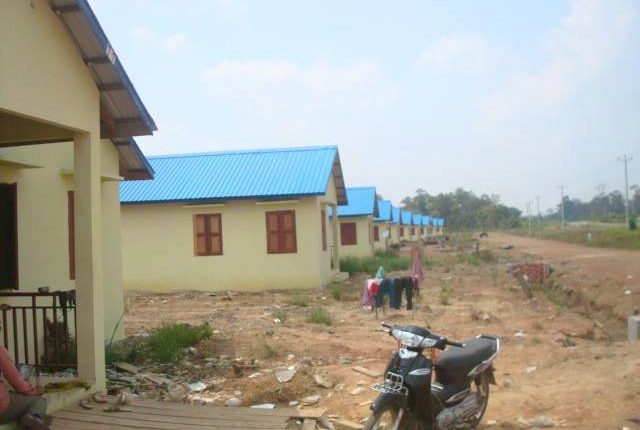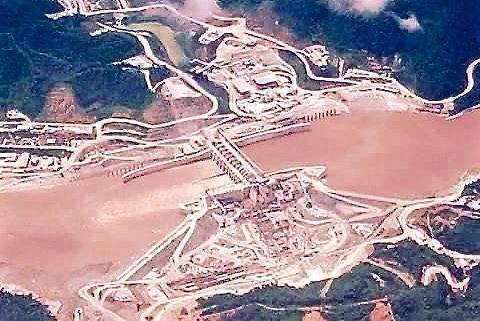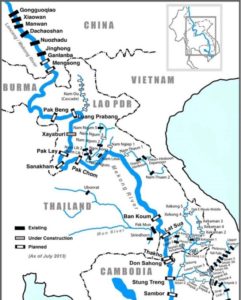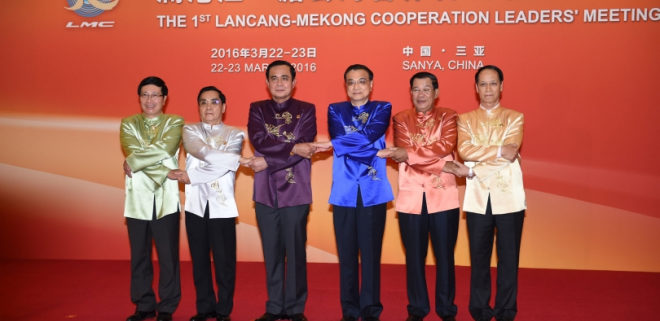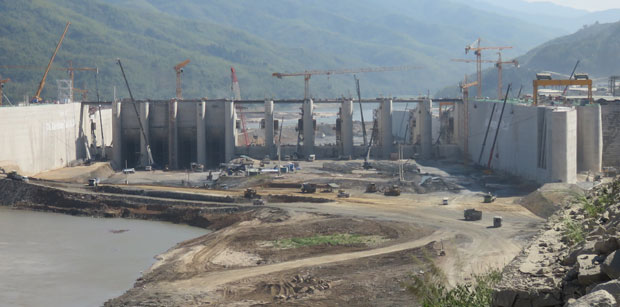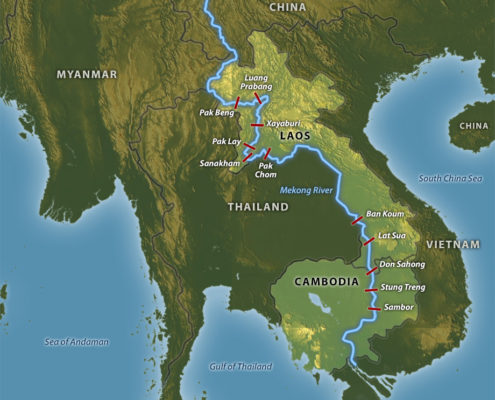By Dr. Lilliana Corredor, Founder, Scientists for the Mekong, June 11, 2017
In this article, we offer an overview and summary of the latest research studies on the impacts of Hydropower Dams and Climate Change on Stream flows in the Mekong River. These variations in Stream Flows in turn, impact on the Mekong River’s ecology, fisheries and on riparian communities dependent on the river for survival.
River management focuses not only on the total volume of water runoff, but also on its flow regime.
Changes in flow regimes in the Mekong River are currently the result of:
- Human activities – through Hydropower Dams, Water diversion for irrigation, Municipal demands, Rural Water Consumption, and Industrial needs. And,
- Climate change – through loss of glaciers at the headwaters of the Mekong River in the Tibetan Plateau, precipitation and evaporation.
These factors significantly alter the hydrological flow patterns, which in turn, change river ecosystems at a basin scale, and thereby, affect aquatic communities, biodiversity, fish reproduction, and the humans that depend on the river products for survival (Kuenzer et al. 2012; Li et al. 2017; Räsänen, T.A., et al. 2017).
A recent study (Räsänen, T.A., et al. 2017) led by researchers from Aalto University in Finland, found that the hydropower projects in the Upper Mekong-Lancang River in China, have caused significant river flow changes to the Mekong River since 2010 & 2014, when the Xiaowan and Nuozhadu mega-dams were respectively completed.
They also found that, changes in water levels by Hydropower Dams in China can be felt 2,000 Km. downstream from the Chinese Dams, as far south as Cambodia. They state:
“An analysis of river flows in Northern Thailand indicates that the hydropower operations considerably increased dry season flows and decreased wet season flows. Furthermore, the study shows that the dry season flows have also become increasingly variable.
The river flow impacts were largest in 2014 after completion of the ‘Nuozhadu dam’, the largest hydropower project in the Mekong Basin, and the impacts were observable over 2000 km downstream in Cambodia. The hydropower operations dampened the Mekong River’s annual flood, which is a key driver of the ecological productivity of the river.
“The river flow changes are feared to affect the ecological productivity of the river and thus the livelihoods, economy and food security of the downstream people. In particular, the impacts on fishing are a major concern because fish and other aquatic animals play a major role in the local and regional economy and food supply.”
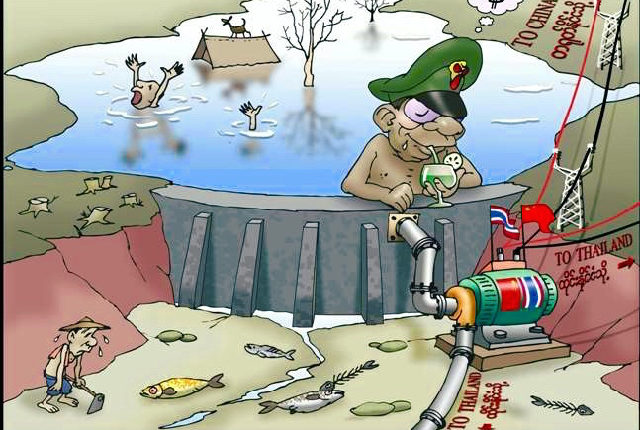
Chinese Dams in the Upper Mekong – Lancang River. via www.burmariversnetwork.org
These results have been further corroborated by another recent study carried out by a group of Chinese researchers (Li, D. et al. 2017) who found that Hydropower Dams not only significantly altered flow regimes, and negatively impacted on ecosystems but also, the impact of Dams superseded the impact of Climate Change on stream-flow regimes. The main points of their research are provided below:
“No dam was constructed on the mainstream of the Mekong River until 1992. China has built six hydropower dams on the mainstream of the Lancang River (i.e., the UMB) since 1992… The two largest dams are Xiaowan (14.56km3 in total storage, completed in 2010) and Nuozhadu (22.4 km3 in total storage, completed in 2014), contributing 36% and 55% of the total storage capacity of all the existing reservoirs in the basin, respectively. Although the streamflow regime has been altered because of large-scale dams the hydropower generation of the Mekong River has kept increasing in recent years (MRC, 2010).
The primary objective of these dams is hydropower generation, which is expected to yield considerable economic benefits for the riparian countries. However, the construction and operation of large dams would also affect the patterns of stream flow, resulting in multiple changes in stream flow regimes, thereby causing a negative impact on ecosystems.
The operation of dams reduces the stream flow in wet seasons and increases the stream flow in dry seasons, resulting in a unique seasonal variation in the stream flow based on eco-flow metrics in the Chiang Saen gauging station, observed from 2010 to 2014. In addition, the maximum flow values decreased significantly in the Chiang Saen gauging station during the year corresponding to the completion of the upstream dams.
The construction and operation of dams clearly have significant impacts on low pulse duration.
It is observed that climate change dictated the changes in the annual streamflow during the transition period 1992–2009 (82.28%), whereas human activities contributed more in the post-impact period 2010–2014 (61.88%). For example, climate change may cause changes in precipitation, increasing the impacts caused by dams as more water would be regulated by reservoirs during the long dry seasons (Lu et al., 2014).”
The seasonal variation in the stream-flow caused by Hydropower Dams, i.e. reducing the stream flow in the wet season, while sporadically increasing the stream flow in the dry season – in an “on & off” basis, results in:
The water flows are contrary to nature’s seasonal rhythms,
go against the ecological needs of ecosystems and species, and
contradict the ‘genetic migration programming’ of aquatic species.
Hence, everything in the River basin goes topsy-turvy, reducing productivity, drying out and then flooding wetlands and riparian zones, confusing the migratory patterns of fish and invertebrates, and blocking the fish progress with a Dam wall to make things worse.
As mentioned above, the construction and operation of Chinese dams in the Upper Mekong-Lancang River clearly have significant impacts on stream-flows and low pulse duration.
The Tonle Sap Lake and the floodplain wetlands are now threatened ecosystems because of the dramatic differences in water levels and the low pulse duration experienced since the construction of the Chinese Dams, Laotian Dams and the Cambodian LS2 Dam; as well as, by the loss of sediments and water pollution. This lake and wetlands are a major and vital area for fish and invertebrate reproduction for the Mekong River basin. However, these issues are diminishing productivity, reproduction and recruitment of fish and invertebrates populations. Migratory birds that use wetlands for roosting are also heavily impacted by loss of habitats.
Of great concern, is the significant decrease of fish stocks and aquatic plants
in the Tonle Sap Lake and wetlands – as a consequence of upstream dams.
Fish and aquatic plants are the main food sources that sustain
over 20,000 of the poorest people in Cambodia.
The loss of Food security is conducive to a Humanitarian Crisis that must be avoided at all costs (Local Chiefs of Tonle Sap Villages, Personal communication (2016); Arias, M.E. et al. (2014).
In regard to the impact of Climate Change on Stream-flows in the Mekong River, this was investigated by Liu, KT et al. (2016) using remote sensing – via Satellite Radar Altimetry. They found melting glaciers in the Tibetan Plateau and a downward trend in rain levels from 2009 to 2015 – indicative of Climate Warming – all of which necessarily reduces the river’s water level. Evaporation and runoff caused further water losses.
“From precipitation perspective, except for normal variability in the annual signal, it is observed a slight downward trend from 2009 to 2015, which is arguably caused by regional climate change [58].
This phenomenon, although gradual, perhaps affects WL [Water Level] variation at the downstream area and requires a longer term observation to quantify the impact… Moreover, the melting glacier in the upper Mekong watershed could also contribute to the water level variations. It is necessary to quantify the freshwater storage changes of these mountain glaciers… Finally, as mentioned before, the rates of evaporation and runoff could vary and cause uncertainty in the water budget as well.”
Discussion
Policy makers ought to start thinking of WATER
and its NATURAL STORAGE areas – i.e. GLACIERS, RIVERS, LAKES & OCEANS, as
precious commodities – an investment that cannot be wasted, blocked or polluted.With the advent of CLIMATE WARMING
Mekong countries ought to be doing all within their power to conserve and honour water systens and reduce Carbon, Nitrous Oxide and Methane emissions produced by
Coal-fired plants and Hydropower Dams
The policy by China, Thailand, Laos, Cambodia and Vietnam to rely on and open more Coal-fired plants to produce electricity for factories and other developments, is non-sensical and dangerous.Rather than facing out fossil fuels they have “decreased” only the “planned amount of plants”.
The Mekong Delta is Vietnam’s fruit, vegetable and rice basket! As well as, home to 20 Million mostly poor people! With the upstream dams blocking most of the nutrient rich sediments that make the Delta fertile and keep it AFLOAT, the Delta is already SINKING. Salt intrusion from raising sea levels and drought, have already damaged over 900,000 hectares of productive land, and in 2016 the first large group of “Environmental Refugees” (over 11,000 people) were displaced and flocked to the nearest cities… homeless and jobless!
Yet, Vietnam recently advertised it will double its Coal-fired plants by 2030 to produce electricity for factories and other developments in the Mekong Delta – mostly for Thailand and China. Effectively, Vietnam is already in the process of killing its “Goose that lays the Golden Eggs – by helping sink its own Delta! It’s doing so by: increasing GHG emissions, thus increasing Climate warming, and by allowing more Dams to be built upstream… When in fact, Vietnam is fully entitled to create a scandal and stop the Dams, given that it will be the country worse hit by loss of sediments & nutrients, as well as, by Climate warming.
If more Dams are built upstream in China, Laos and Cambodia and, Vietnam increases
its GHG emissions through its own Coal-fired plants and Hydropower Dams … then,
the Delta WILL go under water, creating an unprecedented Humanitarian Crisis.
Dr. Le Anh Tuan, deputy director of the Research Institute for Climate Change at Cần Thơ University, and a specialist of the Mekong Delta in Vietnam, recently stated:
“Droughts have been occurring in the Mekong for years. The construction of many hydro-electric power plants on the river has resulted in scarcity of fresh water in the lower Mekong Delta.
The reduction of alluvial soil at hydro dams has also had negative impacts on the quality of the fresh water at the lower end [of the river, in the Delta]. In my opinion, these are problems that need proper attention from local authorities.”
“Việt Nam must also pursue diplomatic measures with countries in the upper regions of the Mekong Delta in order to ensure the equal sharing of water benefits.”
Also, according to Dr. Le Anh Tuan (Personal Communication, Feb. 2016):
“Over 14 Million people in the Mekong Delta will be displaced, effectively becoming “Environmental Refugees“, homeless jobless and hungry, if sea levels rise by 1 meter!
Claudia Kuenzer et al. (2012), have offered in our opinion, a comprehensive summary of the impacts and politics of Hydropower Dams in the Mekong River Basin. It is worth quoting because, although written 5 years ago, it is pretty much current as most issues remain the same or worse:
“Examining hydropower development within the Mekong Basin reveals an obvious conflict interest between the needs of upstream and downstream countries, and especially between the priorities of Mekong upper class decision makers directly or indirectly profiting from the dams and the majority of the rural poor, whose livelihood they put at risk.
Main stem and tributary hydropower dams impact flood pulse timing variability, which can have grave effects on ecologic niches, ecosystems and biodiversity. They lead to a long-term decrease in downstream sediment load, which reduces the nutritious load to plains, wetlands and agricultural areas. Sediment loss is expected to aggravate coastal erosion and saltwater intrusion in the Mekong delta—a region already threatened by sea level rise. [ED: It has. As mentioned above, the Mekong Delta lost thousands of hectares of productive land in 2016 due to Salt water intrusion and lower sediments loads.]
Endangered natural environments are, however, not only the Mekong delta, but also the Tonle Sap and southern Cambodian floodplains. These regions host over one-third of the Mekong Basin population, which depends heavily on fish catch as a source of daily protein.
Migrating fish will, however, be hindered on their pathway by hundreds of metres of high concrete walls. Fish ladders on such constructions have proven to be mostly inadequate in design, and also cannot prevent migratory fish from losing their sense of orientation when they end up in a slow flowing large reservoir instead of a stream.
At the dam sites themselves, forced relocation of rural populations often leads to a decrease in resilience and impoverishment.
All the above underline the complexities of the water-food-energy nexus in the Mekong region. Many authors argue that the environmental and social costs of cascading the Mekong and its tributaries probably outweigh the benefits of energy generation, improved navigability, and associated economic development. In public media and the public debate, the large-scale transboundary impact of hydropower development is a politically charged topic. First and foremost, the main stem cascade of China is brought up when explanations are needed for any abnormal downstream situations. However, many authors addressing the topic of dam impact in the Mekong have come to contradictory results and conclusions.
Many studies and assessment reports are biased and guided by the complex interests of their respective institutions.
Flow and sediment related data often lack temporal or spatial coherence, and it is difficult to derive clear quantitative statements, although the general trends seem clear. Additional impacts on the variability of Mekong water flows, such as increasing water consumption for urban and rural areas, land use change, and the influence of climate variations, must be considered. At the same time, planned mainstream dams as well as operational and planned tributary dams in the lower Mekong Basin need to move more to centre stage. The Xayaburi case is a first good example, and more should follow. Despite the strong opposition of local populations to the dams of upstream riparian neighbours it is often forgotten that their own country’s government, companies and other interest groups are closely engaged in building and operating dams on their own territory—or are at least involved in electricity transfer schemes.
Therefore, the common apprehension that downstream countries suffer unilaterally from the negative impacts of hydropower development in upstream countries seems only partly justified. The interests of upstream and downstream countries are not clear-cut because of the economic interaction of all Mekong riparians. All Mekong countries are involved in the regional power trade triggered by the GMS initiative. Thailand and Vietnam are the main net importers of electricity from upstream countries; Yunnan Province and Laos are the main net-exporters of electricity.
Cambodia and Myanmar have large potential hydropower energy use, and especially Cambodia plans to increase hydropower development to benefit from electricity exports. Thailand and Vietnam support hydropower development in their neighbouring countries by providing national funds for investment in hydropower projects. In addition, especially Vietnam exploits its own hydropower potential without considering the impact on the Mekong delta further downstream.
Many media, NGOs and INGOS emphasize the negative impacts of upstream dams, while at the same time national governments are signing large power trade deals in the background. Currently, each country tries to capitalize on its river location, regardless of the pending consequences for the overall health of the hydraulic system.
The arena of players influencing the hydropower debate in the Mekong is extensive. It ranges from large international and national banks to riparian and non-riparian governments, private corporations, companies, supra-regional bodies and networks to INGOs, NGOs, foundations, scientific institutions, media and even to individual power-elite decision makers and lobbyists, all with their own interests.
Whereas the future of Mekong hydropower seems to be shaped mainly by economic cooperation under the Greater Mekong Subregion Initiative, the role of the Mekong River Commission remains unclarified. If its members do not commit themselves to empowering this organisation to plan and implement river basin management, its influence via the development of recommendations, norms, and standards will be meagre.
Much stronger involvement of local communities and local studies in impact assessments, the development of mechanisms to foster true cross-sector, trans-disciplinary dialogue that can percolate through different hierarchical levels of decision making, the harmonisation of assessment methods and data analyses, and an improved communication of Mekong related information in all riparian languages are only some of the challenges urgently needing attention.
An important part of the puzzle that was left out, was not as clear at the time, and that is: the Water Hegemony by China. In its haste for power over the region in 2016 China formed the Lancang-Mekong Cooperation Group, which it controls. All riparian countries in the Mekong Basin now form part of this alliance, based on Trade Deals and Development goals.
Thus, China now reigns supreme, establishes the rules and dictates who can speak about what and vetoes subjects no one must criticize, such as: its South China Sea invasion, prohibition of Oil drilling in the South China Sea, and its 14 more planned Hydropower dams in the Upper Mekong-Lancang River…
Repression and Abuse of Human Rights have increased in the region in the last year, with most LMB ountries following China’s Iron Fist rule.
We fully agree that a stronger involvement of affected communities is essential in decision-making. Unfortunately, none of the above suggestions has truly eventuated, leaving 60 million poor people’s nutrition, health and livelihoods hanging in the balance… being forced by China’s into a “Market- lifestyle” instead of a “subsistence- lifestyle.“ Interestingly enough, the former actually exacerbates “poverty”, while the latter allowed them self-sufficiency, which they are now being deprived of.
A recent article by Pham Ngoc Bao et al. (2017) of the Institute of Global Environmental Strategies, suggests the need for an “integrated approach to establish a regional mechanism for sustainable hydropower development in the Mekong River Basin.” It states:
“Based on a critical review of the current trend of hydropower development, it (is) argued that existing approach of uncoordinated Mekong mainstream hydropower development cannot ensure sustainable development; rather it causes negative impacts on food security, livelihoods, biodiversity, and ecosystem across the river basin, especially countries in Lower Mekong Basin (LMB), including Cambodia, Thailand and Vietnam. As a result, it fails to bring positive net benefits at both national and regional level.
Specifically, if all proposed mainstream dams are constructed and fully operated, Lao PDR is the only economically winner of billions USD after 20 years, while Thailand, Cambodia, and Viet Nam are losers, and total net value will be minus 275 billion USD.
Early recognition of the “nexus” interactions amongst hydropower development and cross-border food security, water security and livelihoods can minimise the risk of diplomatic conflicts and social unrest, and is only enabled when member states are willing to divert high-level government priorities from national interests to transboundary interests, as implementing the nexus approach throughout the river basin could contribute to reducing trade-offs between hydropower development and basin-wide socio-economy, and increase synergies through implementation of benefit-sharing mechanisms towards a win-win outcome.
It recommends strengthening the Mekong River Commission via bolstered resources and coordinating authority, and encourages China to participate as a full member. It also argues that transboundary Environmental Impact Assessments (EIA) of river projects should be conducted to reflect the synergic and trade-off nexus effect across the whole river basin.”
While we agree with most of their statement, we doubt the MRC is a good organization to fulfill the desired results. The MRC has become a pawn of Laos, Thailand & China, promoting Hydropower and turning the blind-eye to Dam construction going ahead without proper EIAs and studies suggested by many scientists. The MRC uses the excuse that “it doesn’t have the power to interfere, and that it’s up to the riparian governments to sort out their issues.”
We suggest that a New Committee be formed by: Diplomatic representatives of all Mekong riparian nations including China, scientists specialized in the Mekong River, Environmental adjudicators, Human Rights Defenders, CSOs and a strong presence of representatives of Riparian Communities affected by the Dams. And, NOT based in Laos.
A good recent example of how local governments exclude representatives of affected communities and civil society groups, is the New Committee announced by the Stung Treng government in Cambodia. It is meant to address the concerns of the communities affected by the Lower Sesan2 Dam. Yet, it fails to have any community representatives, which is outrageous. Decisions cannot be made on behalf of communities without consulting them, and asking their input and KNOWLEDGE of the river, learned by living by the river. They know best what their needs are.
Summary
The seasonal variations in stream flows create a significant ecological imbalance that impacts profoundly on the whole river basin, and on the riparian communities that are dependent on the river for survival by:
- reducing nutrients and sediments
- reducing productivity
- reducing Organic Carbon transfer from Rivers to the Ocean
- scouring river beds
- damaging wetlands – thus, damaging the nurseries for fish & invertebrates
- reducing fish & invertebrate reproduction
- reducing supply of aquatic plants for human consumption
- reducing fish stocks
- reducing biodiversity
- leading to extinction of many species
- reducing the food supply – of the millions of people living in riparian communities
- jeopardizing the livelihoods – of the millions of people dependent on the river for survival
- flooding and damaging riverside vegetable gardens – thus impacting on another source of food supply for poor riparian communities
- flash-floods damaging houses, crops and killing livestock,
- increasing malnutrition, poor health and poverty… and
- reducing Carbon Sinks!
===============
Literature Reviewed
Arias, M.E. et al. (2014). Dams on Mekong tributaries as significant contributors of hydrological alterations to the Tonle Sap Floodplain in Cambodia – Hydrol. Earth Syst. Sci. Discuss., (HESSD), 11: 2177–2209 http://www.hydrol-earth-syst-sci-discuss.net/11/2177/2014/hessd-11-2177-2014.html
Download here:
https://www.academia.edu/20957408/Dams_on_Mekong_tributaries_as_significant_contributors_of_hydrological_alterations_to_the_Tonle_Sap_Floodplain_in_Cambodia
Arias, M.E., Cochrane, T.A., Kummu, M., Lauri, H., Holtgrieve, G.W., Koponen, J., Piman, T., (2014).
Impacts of hydropower and climate change on drivers of ecological productivity of Southeast Asia’s most important wetland. Ecol. Model. 272, 252-263. http://dx.doi.org/10.1016/j.ecolmodel.2013.10.015
Download here:
https://www.academia.edu/20957409/Future_sediment_dynamics_in_the_Mekong_Delta_floodplains_Impacts_of_hydropower_development_climate_change_and_sea_level_rise
Räsänen T.A., O. Joffre, P. Someth & M. Kummu (2013). Trade-offs between Hydropower and Irrigation Development and their Cumulative Hydrological Impacts: A case study from the Sesan River.
In book: Challenge Program on Water & Food Mekong project MK3 “Optimizing the management of a cascade of reservoirs at the catchment level”. Publisher: ICEM – International Centre for Environmental Management, Hanoi Vietnam, pp.33
Download here: https://www.researchgate.net/publication/262276641_Trade-offs_between_Hydropower_and_Irrigation_Development_and_their_Cumulative_Hydrological_Impacts
Räsänen, T.A., et al. 2017. Observed discharge changes due to hydropower operations in the Upper Mekong Basin. Journal of Hydrology, 545, 28-41. DOI: 10.1016/j.jhydrol.2016.12.023.
Download Here: www.aalto.fi/en/current/news/2017-01-02-003/
Hoang, LP (2016). Mekong River flow and hydrological extremes under climate change. Hydrol. Earth Syst. Sci., 20, 3027–3041_ July 29, 2016. Download here:
www.hydrol-earth-syst-sci.net/20/3027/2016/hess-20-3027-2016.pdf
Liu, KT et al. (2016). Assessment of the Impact of Reservoirs in the Upper Mekong River Using Satellite Radar Altimetry and Remote Sensing Imageries. Remote Sens. 2016, 8, 367; doi:10.3390/rs8050367. Download here:
www.mdpi.com/2072-4292/8/5/367/pdf
Li, D., Long, D., Zhao, J., Lu, H., Hong, Y. (2017). Observed changes in flow regimes in the Mekong River basin, Journal of Hydrology (2017), doi: http://dx.doi.org/10.1016/j. jhydrol.2017.05.061.
Download Here:
http://www.sciencedirect.com/science/article/pii/S0022169417303906
Maavara, T. et al. (2017). Global perturbation of organic carbon cycling by river damming – Nature Communications 8, Article number: 15347. May 17, 2017. doi:10.1038/ncomms15347.
https://www.nature.com/articles/ncomms15347
Kuenzer, C. et al. (2012). Understanding the impact of hydropower developments in the context of upstream–downstream relations in the Mekong river basin. Sustainability Science · August 2012.
DOI 10.1007/s11625-012-0195-z
Download here:
https://www.researchgate.net/publication/237100980_Understanding_the_Impacts_of_Hydropower_Developments_in_the_Context_of_Upstream-Downstream_Relations_in_the_Mekong_River_Basin
Mekong water diplomacy vital. Environment – Vietnam News, March 07, 2017. http://vietnamnews.vn/environment/372179/mekong-water-diplomacy-vital.html#LGYi8RXwGk8itwVD.97 ]
‘Environmental refugees’ in Mekong River Delta expected in future, experts say – News VietNamNet, Nov. 2, 2016.
http://english.vietnamnet.vn/fms/environment/166283/-environmental-refugees–in-mekong-river-delta-expected-in-future–experts-say.html
Mekong Delta to lack sufficient water in future, experts warn. VietnamNet – Oct. 11, 2016. http://english.vietnamnet.vn/fms/environment/164642/mekong-delta-to-lack-sufficient-water-in-future–experts-warn.html
Vietnam’s Mekong Delta faces most serious drought, salinization in 90 years – Feb 18, 2016 http://tuoitrenews.vn/society/33283/vietnams-mekong-delta-faces-most-serious-drought-salinization-in-90-years
Vietnam warns of dire impact from planned Mekong dams – Bangkok Post – 5 April 2016 http://www.bangkokpost.com/news/asean/922373/vietnam-warns-of-dire-impact-from-planned-mekong-dams
Pham Ngoc Bao et al. (2017). Integrated Approach for Sustainable Hydropower Development in the Mekong River Basin. Environment and Natural Resources Research; Vol. 7, No. 1; 2017
Download here: https://www.researchgate.net/publication/313541328_Integrated_Approach_for_Sustainable_Hydropower_Development_in_the_Mekong_River_Basin?
New body to address Sesan dam concerns. Phnom Penh Post, Jan 27, 2017.
http://www.phnompenhpost.com/national/new-body-address-sesan-dam-concerns

